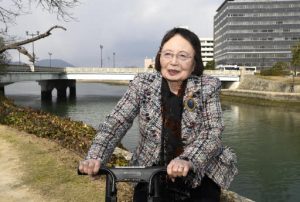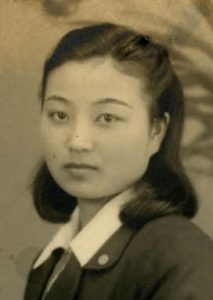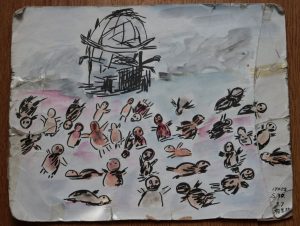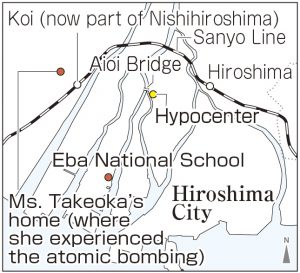Survivors’ Stories: Chisako Takeoka, 92, Hiroshima, searched for missing mother amid piles of bodies
Mar. 2, 2020
Has conveyed her A-bombing experience over 40 years to sow seeds of peace
by Miho Kuwajima, Staff Writer
Chisako Takeoka (née Doi), now 92, wandered around Hiroshima in the aftermath of the atomic bombing when she was 17 in search of her mother. She witnessed an infant who had been burned to death and a young girl’s skeletal remains. She has shared her A-bombing experience with other people for about 40 years. “I am absolutely opposed to war. Let’s instead sow seeds of peace,” Ms. Takeoka conveys in her testimonies.
After graduating from Yamanaka Girls High School, attached to Hiroshima Women’s Higher School of Education in Senda-machi (now part of Naka Ward), Ms. Takeoka was mobilized to work at Toyo Seikan, a manufacturing plant in the Nishitenma district (now part of Nishi Ward), then used as a military factory for the production of manned torpedoes. She was a member of a corps of women volunteer workers. On August 6, she had plans to go to the island of Miyajima with friends, on her day off after having worked the previous night’s shift.
As she picked up a hand mirror and was fixing her hair at the front door of her home, located in the town of Koi (currently part of Nishi Ward), there was a flash of light. She was blown out to the field behind her house by the bomb’s blast. Though her home stood on a hill three kilometers from the hypocenter, the roof and windows were blown away. Looking down in the direction of the city, she saw a black mass move as one up the hill. It was a group of people whose hair had been scorched and skin burned and peeled from their bodies. Together with her neighbors, she encouraged the victims with her words. “Don’t give up, don’t die,” she said while giving them water.
Chisako’s mother Ryo Kunisada, then 42, who worked as chief nurse at the military hospital near Aioi Bridge, failed to return home. In the morning on the following day, Chisako wore an air-raid hood, wet from water she had doused it with, and left home to search for her mother. When she arrived at Aioi Bridge, she found the stone railings collapsed. Both the river and its banks were filled with burned and swollen corpses.
“My legs shook from the anger I felt, thinking I would never ever forgive the United States,” said Ms. Takeoka. An Army medic who was pulling floating bodies from the river recommended she take a look at the bodies to find her mother. Ms. Takeoka forcefully opened the mouths of the corpses with a piece of wood to try and confirm whether they had three gold teeth, as her mother did.
After walking around the city for six days, she visited the Eba National Elementary School (now Eba Elementary School). A woman lying on the desk with her face wrapped in bandage called out to her using her nickname “Chi-chan.” She had finally found her mother. On the morning of August 6, her mother had gone to Funairi Hospital (now part of Naka Ward) instead of her usual hospital, located close to the hypocenter, because she had had an errand to run. That is how she escaped instant death.
Along with her neighbor, she brought her mother back home. When her mother’s bandage was removed, her right eye was found to be crushed, with an appearance like an umeboshi (dried Japanese plum), and protruding from her eye socket. She had heard there were doctors at the national elementary school in the village of Hesaka (now part of Higashi Ward), and so she took her mother to the school on a cart she pulled behind her. Without anesthesia or a surgical table, a veterinarian hollowed out her mother’s injured eye with a scalpel. Ms. Takeoka still remembers her mother’s cries of anguish during the surgery.
Her mother managed to recover and lived for about 20 more years. Ms. Takeoka married in 1947, when she was 20, and soon gave birth to a son, Hironori. However, 18 days after birth born, he suddenly died. She held his tiny body and went to the Hiroshima Red Cross Hospital, where she was told the cause of her son’s death was “atomic bomb disease.” It was then she recalled having purple spots on her body and suffering from nausea after she had searched for her mother.
The atomic bombing has afflicted human health regardless of the number of years passed. With anger, she recounted her experiences to local communities and published a collection of testimonies from A-bomb survivors on the occasion of the 40th anniversary of the atomic bombing. In 1982, she took the witness stand at the second special session on disarmament at the United Nations, held in the United States. Starting eight years ago, she began working as an instructor for “memory keepers,” those who, on behalf of A-bomb survivors, convey A-bombing experiences. The city government of Hiroshima has been training such personnel, and 12 of the memory keepers, including Mariko Higashino, 67, Ms. Takeoka’s oldest daughter, have continued to convey her particular story.
At the time Pope Francis visited the Hiroshima Peace Memorial Park in November last year, Ms. Takeoka participated in a gathering with him as an A-bomb survivor representative. She conveyed to the pope her wish to be part of efforts to share her experience. “I have continued to sow seeds for peace.” When she said this, the pope grasped her hands tightly. She felt that by doing so, he had expressed his will to work together toward a peaceful world.
“After children listen to the testimony of my A-bombing experience, they honestly tell me that there shouldn’t be war. I want to increase the number of such people to the extent possible,” Ms. Takeoka explained. Her resolve is as strong as ever, despite being more than 90 years old.
Teenager impressions
I will continue conveying these messages even at college
Living in peace since we were born, it is difficult to actually feel the reality of the lives of people during World War II. So, we can only imagine what they went through in their lives. I am going to graduate from high school soon, and I feel I was able to go to school because we live in peace. I want to carry on the wishes of Ms. Takeoka, who emphasized that “Wars should never be accepted,” and convey messages that lead to creation of a peaceful world even after I go to college. (Riho Kito, 18)
War is unforgivable, as it robs us of family
I was struck by these words that Ms. Takeoka spoke, “I heard my mother scream during the operation, and I felt like that was a living hell.” If I had witnessed my own family members suffering from pain like that, I would have felt scared, angry, and an extreme hatred of war. Her comments made me aware that war not only takes away loved ones but also leaves those who survive to suffer great hardship. I felt I must convey that message to the next generation. (Chihiro Tawara, 13)
Helping others in difficult times
Soon after the atomic bomb was dropped, Ms. Takeoka made triangular bandages using a yukata (summer kimono) and provided first aid to an elderly woman who had been injured from glass shrapnel piercing her entire body. Instead of taking care of herself, she lent a helping hand to people around her. When I listened to that, I felt her story was incredible. No matter how tough a situation I happen to be in, I want to proactively help those in need around me, just as she did. (Felix Walsh, 18)
(Originally published on March 2, 2020)
by Miho Kuwajima, Staff Writer
Chisako Takeoka (née Doi), now 92, wandered around Hiroshima in the aftermath of the atomic bombing when she was 17 in search of her mother. She witnessed an infant who had been burned to death and a young girl’s skeletal remains. She has shared her A-bombing experience with other people for about 40 years. “I am absolutely opposed to war. Let’s instead sow seeds of peace,” Ms. Takeoka conveys in her testimonies.
After graduating from Yamanaka Girls High School, attached to Hiroshima Women’s Higher School of Education in Senda-machi (now part of Naka Ward), Ms. Takeoka was mobilized to work at Toyo Seikan, a manufacturing plant in the Nishitenma district (now part of Nishi Ward), then used as a military factory for the production of manned torpedoes. She was a member of a corps of women volunteer workers. On August 6, she had plans to go to the island of Miyajima with friends, on her day off after having worked the previous night’s shift.
As she picked up a hand mirror and was fixing her hair at the front door of her home, located in the town of Koi (currently part of Nishi Ward), there was a flash of light. She was blown out to the field behind her house by the bomb’s blast. Though her home stood on a hill three kilometers from the hypocenter, the roof and windows were blown away. Looking down in the direction of the city, she saw a black mass move as one up the hill. It was a group of people whose hair had been scorched and skin burned and peeled from their bodies. Together with her neighbors, she encouraged the victims with her words. “Don’t give up, don’t die,” she said while giving them water.
Chisako’s mother Ryo Kunisada, then 42, who worked as chief nurse at the military hospital near Aioi Bridge, failed to return home. In the morning on the following day, Chisako wore an air-raid hood, wet from water she had doused it with, and left home to search for her mother. When she arrived at Aioi Bridge, she found the stone railings collapsed. Both the river and its banks were filled with burned and swollen corpses.
“My legs shook from the anger I felt, thinking I would never ever forgive the United States,” said Ms. Takeoka. An Army medic who was pulling floating bodies from the river recommended she take a look at the bodies to find her mother. Ms. Takeoka forcefully opened the mouths of the corpses with a piece of wood to try and confirm whether they had three gold teeth, as her mother did.
After walking around the city for six days, she visited the Eba National Elementary School (now Eba Elementary School). A woman lying on the desk with her face wrapped in bandage called out to her using her nickname “Chi-chan.” She had finally found her mother. On the morning of August 6, her mother had gone to Funairi Hospital (now part of Naka Ward) instead of her usual hospital, located close to the hypocenter, because she had had an errand to run. That is how she escaped instant death.
Along with her neighbor, she brought her mother back home. When her mother’s bandage was removed, her right eye was found to be crushed, with an appearance like an umeboshi (dried Japanese plum), and protruding from her eye socket. She had heard there were doctors at the national elementary school in the village of Hesaka (now part of Higashi Ward), and so she took her mother to the school on a cart she pulled behind her. Without anesthesia or a surgical table, a veterinarian hollowed out her mother’s injured eye with a scalpel. Ms. Takeoka still remembers her mother’s cries of anguish during the surgery.
Her mother managed to recover and lived for about 20 more years. Ms. Takeoka married in 1947, when she was 20, and soon gave birth to a son, Hironori. However, 18 days after birth born, he suddenly died. She held his tiny body and went to the Hiroshima Red Cross Hospital, where she was told the cause of her son’s death was “atomic bomb disease.” It was then she recalled having purple spots on her body and suffering from nausea after she had searched for her mother.
The atomic bombing has afflicted human health regardless of the number of years passed. With anger, she recounted her experiences to local communities and published a collection of testimonies from A-bomb survivors on the occasion of the 40th anniversary of the atomic bombing. In 1982, she took the witness stand at the second special session on disarmament at the United Nations, held in the United States. Starting eight years ago, she began working as an instructor for “memory keepers,” those who, on behalf of A-bomb survivors, convey A-bombing experiences. The city government of Hiroshima has been training such personnel, and 12 of the memory keepers, including Mariko Higashino, 67, Ms. Takeoka’s oldest daughter, have continued to convey her particular story.
At the time Pope Francis visited the Hiroshima Peace Memorial Park in November last year, Ms. Takeoka participated in a gathering with him as an A-bomb survivor representative. She conveyed to the pope her wish to be part of efforts to share her experience. “I have continued to sow seeds for peace.” When she said this, the pope grasped her hands tightly. She felt that by doing so, he had expressed his will to work together toward a peaceful world.
“After children listen to the testimony of my A-bombing experience, they honestly tell me that there shouldn’t be war. I want to increase the number of such people to the extent possible,” Ms. Takeoka explained. Her resolve is as strong as ever, despite being more than 90 years old.
Teenager impressions
I will continue conveying these messages even at college
Living in peace since we were born, it is difficult to actually feel the reality of the lives of people during World War II. So, we can only imagine what they went through in their lives. I am going to graduate from high school soon, and I feel I was able to go to school because we live in peace. I want to carry on the wishes of Ms. Takeoka, who emphasized that “Wars should never be accepted,” and convey messages that lead to creation of a peaceful world even after I go to college. (Riho Kito, 18)
War is unforgivable, as it robs us of family
I was struck by these words that Ms. Takeoka spoke, “I heard my mother scream during the operation, and I felt like that was a living hell.” If I had witnessed my own family members suffering from pain like that, I would have felt scared, angry, and an extreme hatred of war. Her comments made me aware that war not only takes away loved ones but also leaves those who survive to suffer great hardship. I felt I must convey that message to the next generation. (Chihiro Tawara, 13)
Helping others in difficult times
Soon after the atomic bomb was dropped, Ms. Takeoka made triangular bandages using a yukata (summer kimono) and provided first aid to an elderly woman who had been injured from glass shrapnel piercing her entire body. Instead of taking care of herself, she lent a helping hand to people around her. When I listened to that, I felt her story was incredible. No matter how tough a situation I happen to be in, I want to proactively help those in need around me, just as she did. (Felix Walsh, 18)
(Originally published on March 2, 2020)











